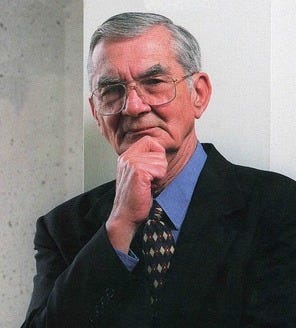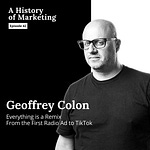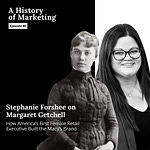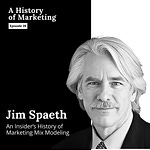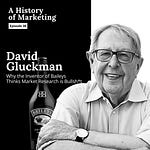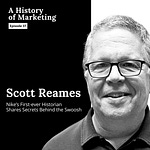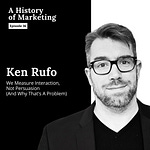A History of Marketing / Episode 21
This week, I'm delighted to be joined by Professor Rachel Kennedy, Associate Director (Product Development) of the renowned Ehrenberg-Bass Institute.
The Ehrenberg-Bass Institute for Marketing Science is a leading organization in research on how to grow brands. Professor Kennedy herself ranks globally in the top 1% of advertising researchers and is highly regarded for her work in bringing evidence-based research into tangible marketing practice.
In our conversation, Professor Kennedy shares fascinating insights into the work of marketing science pioneers like Andrew Ehrenberg and Frank Bass, and the founding principles of the Ehrenberg-Bass Institute in Adelaide, Australia. We explore their core concepts on how brands actually grow and discuss the global impact of the Institute's groundbreaking work.
Listen to the podcast: Spotify / Apple Podcasts / YouTube Podcasts
This conversation is packed with important concepts when it comes to measuring marketing’s effectiveness, including:
The concept of Empirical Generalization and why the Eherenberg-Bass Institute believes it’s a revolutionary approach to understanding marketing
Key concepts like Double Jeopardy and Negative Binomial Distribution (NBD), explained in an accessible way.
What happens when brands "go dark" and stop advertising, and the real impact on sales and market share.
The importance of ad likability and how it connects (or doesn't) to advertising effectiveness.
How the Ehrenberg-Bass Institute translates research into strategies for brand growth.
And much more.
Now, here's my conversation with Professor Rachel Kennedy.
Note - I use an AI tool to transcribe the audio of my conversations to text. I check the output but it’s possible there are mistakes I missed. Parts of this transcript have been edited for clarity.
Andrew Mitrak: Professor Rachel Kennedy, welcome to A History of Marketing.
Professor Rachel Kennedy: Thank you, Andrew. Absolute pleasure to be here. Thank you for the opportunity.
Viva La Revolution: The Ehrenberg-Bass Approach to Marketing Science
Andrew Mitrak: I'm looking forward to a conversation about the Ehrenberg-Bass Institute, your expertise on advertising and media effectiveness. To start, I thought I'd ask you about a research paper that you sent me in advance of this interview. It's called "Viva La Revolution! For Evidence-Based Marketing We Strive." When I saw this, I thought, “What?! This is an unusual title for an academic paper.”
You're positioning yourselves as revolutionaries. Can you tell me about this, what was this revolution, and what were you reacting to?
Rachel Kennedy: Well, the revolution still continues. We are just so different from most of the marketing academics around the world in many ways, particularly how we study marketing. Because we study it in a very different way, we see different things. It's as different as people seeing the world being flat versus other people who see it round. It is that different.
The revolution we're encouraging people to join, and have been for decades, is to stop and look at the evidence that we see because it changes what you see, and we think it changes things for the better. We'll definitely come to some of that, but that's the big picture of the call to action.
It's not the first time we've been seen as being different. We're different in many ways. That's why I reached out to you; because you were talking about the history of marketing, I thought it was really important that we share that there is this very different way of looking at it, but importantly, that is discovering new knowledge and changing the way marketing is done around the world.
Empirical Generalization and the Pursuit of Evidence-Based Marketing
Andrew Mitrak: When you say "we," are you referring collectively to the Ehrenberg-Bass Institute, or does this paper also talk a lot about this group called the Empirical Generalizationists and this research tradition? Are those one and the same? Empirical Generalizationists, I'll just call it EG from now on, by the way, it's a mouthful. How do we think of EG and the Ehrenberg-Bass Institute? Are those the groups collectively?
Rachel Kennedy: Empirical generalization is a thing that's far bigger than the Institute. In marketing, we are key proponents of it, but not the only ones who see its value. We're intimately linked with it, and as a team, we're large, the largest in the world studying marketing. We're incredibly cohesive in our belief that this is the way to make discoveries and to advance our discipline. We are disciples trying to spread the word, and we live and breathe it, but others do as well.
The idea of coming up with empirical generalizations is broader than marketing. In fact, what we do is take the approaches that are done in the physical sciences, the ways of studying the world, and apply them to studying the things marketers are interested in: How do brands compete with each other? How do brands grow? How do marketing levers work?
We study them in the same way that physical scientists do, which begins with pattern spotting: describing the world that we're interested in, ideally with as much data as possible, importantly across diverse conditions or data collected in different ways (survey, behavioral data, the more diverse the better).
We pattern spot and, across known conditions, document how things are related. We're very focused on sameness, where things are the same, and documenting the conditions where they're not.
This is such a different approach to most marketing study, where it's about single data sets, where people are doing complex models looking for statistical differences. We're looking across conditions, across data sets, looking for sameness, looking for what robust knowledge is likely to hold. When you've done enough pattern spotting that you see these robust patterns, the idea is to quantify it. The end point we're looking for is maths and laws that describe those big patterns.
We're very associated and known for laws like double jeopardy. Small brands will always be hit twice; they have fewer buyers who buy less often. Duplication of purchase, sharing across brands is predictable based on the size of those brands. Negative binomial distribution, buying skews light, natural monopoly, it goes on, but that's what empirical generalizationists are looking for: simple laws that describe the big picture of how the world works. As researchers, we're always interested in the nitty-gritty and the deviations, but as a discipline, understanding that big picture helps us understand what matters. It helps us know what constructs we should be studying. It helps us predict the future and understand the world in ways that we don't think traditional studies achieve quite so well.
Andrew Ehrenberg and Frank Bass
Andrew Mitrak: Can you tell me, where did this idea of empirical generalization come from? Who were the originators of this thought? Also, if you can share how you came across it for the first time?
Rachel Kennedy: Personally, and as the Institute (because as you'll see in our name, we're the Ehrenberg-Bass Institute for Marketing Science), we're inspired by both of those individuals. I'll talk about Frank (Bass) first. I never got to meet him, but I'm definitely inspired by his work. Both of them were marketing professors, born in the same year, both very quantitative in their background.
Frank Bass studied maths at Harvard, but the thing that inspired us, in terms of studying the real world and implementing marketing science, was that he came up with the diffusion model. So understanding how new technologies and new products come to market and their life cycle. Studying the real world, underpinned by data, and quantifying it in models—that's core to what we believe matters.
Andrew Ehrenberg, I was lucky enough to work with him in '99 and 2000 in the UK, had a very strong relationship with the Institute, and very much inspired us down this journey of empirical generalization. I can talk more about him just because I spent so much time with him. In terms of your history channel, I can probably share a few more snippets which are really important to me and important to our journey as an institute, as well as my own journey.
He was originally born in Germany. His father was a staunch critic of the Nazis, so his family had to move to the UK. He studied statistics, a highly trained statistician. He understood data and numbers incredibly well and drew on that through his life. In hindsight, he was probably also inspired by a father who was a staunch critic to stand up and talk about what he believed and saw in data, which has been an important part, perhaps going back to your first question of why we see it as a revolution and that it's important to share these beliefs. Again, inspired by him.
Anyway, he was a statistician. He was employed by, I think was the name of a large panel provider, to analyze their data across different categories. Marketers kept asking him to do things like the report on the loyalty of brands. He was looking at the data—he wasn't a marketer, he was a statistician—and he'd go, "Why do they keep talking about loyalty when I look at what people buy and they're not loyal?" And they're buying skews light, things that were in total contrast to the language and what the marketers were wanting him to see in the data.
That led him to this journey of documenting the patterns in buyer behavior data—patterns about how people buy and how brands compete with each other—that led him to make some incredibly important discoveries in marketing, like the negative binomial distribution, that brands have these predictable patterns in terms of how people buy them, how they compete. He definitely was my inspiration.
Not only did he talk about how there were these patterns in marketing that we should document—he was published in Nature, a top scientific journal, showing these patterns, along with many other places—so he shared that message. He also was heavily focused on how it is that you share information. He wrote a book about data reduction so that you can see these patterns. Many things about him inspired us in our journey.
The NBD-Dirichlet Model
Andrew Mitrak: You mentioned negative binomial distribution, and that's one I've seen come up in the work of the Ehrenberg-Bass Institute, and it's mentioned in the paper you sent over. I'm not a mathematician. Those words, negative binomial distribution Dirichlet—I hope I'm pronouncing that correctly. Could you explain this concept to somebody who's not an expert in math? What is the overall “dummy” version of how to think about this idea?
Rachel Kennedy: Okay, there are two different things there, which do come together. The NBD-Dirichlet is a model that Andrew Ehrenberg with colleagues, Gerald Goodhardt and Mark Uncles and others, brought together. It is the maths that describes a lot of those laws I mentioned earlier. Embedded in that total model is the maths for double jeopardy, duplication of purchase, natural monopoly. It is maths that describes how brands compete with each other.
The negative binomial distribution part is a pattern we see that all brands hold: big brands, small brands, brands in different markets across categories. When you fit that maths, it gives you the number of how many people will buy a brand once in a year, twice, 50 times if that's relevant to the category. It's relatively simple maths—beyond me to create, but relatively simple—but it describes the big patterns that we see time and time again.
Andrew Mitrak: If I was to come back to your idea of you being revolutionaries and what you're reacting against, I think one concept that might be a myth or something not backed up by the data is something like an 80/20 Pareto principle or things like that that are sort of myths you hear bandied about.
Rachel Kennedy: Even though that one's called a law, that is not what we see in the data. It's not what we see in the real world.
Andrew Mitrak: And the NBD would be a better reflection of what you see in the data and what you see in the real world, something that would contradict more of an 80/20?
Rachel Kennedy: Absolutely. Maths is a simplification of the world. E=mc², it describes it really well. It gives you the big picture. It helps you understand what matters. It's the same with the NBD-Dirichlet. Within the Institute, we've had decades of testing it. Does it fit really well for durables in the same way that it does package goods? How do services look? It gives us the big picture, and it has proven itself to be remarkably accurate—not saying perfect, but remarkably accurate. It focuses marketers on the things that matter most.
So that's the maths part of it. But as an institute and as scientists, that's absolutely critical and part of the journey. But we're also interested in, “What does that tell us about theory? What does that tell us about the constructs that really matter to marketers?” So by understanding those patterns, there are very clear lessons. So, big picture: if a brand wants to grow, penetration is king. You don't get there without nudging more buyers towards your brand. So that has to become a metric that marketers matter.
So Andrew was incredibly important: we named our institute out of him. We continue to talk about him all of the time and inspired by him and Gerald Goodhart, Frank Bass, others, but we've continued that journey of pattern spotting and translating what those patterns mean for practice. And that's where, in terms of you ask the question of what is this revolution, as an institute, we're very focused on taking that maths and translating it into practice. Our mission is to create discoveries about marketing and the things that matter and to disseminate that knowledge so we have a real-world impact. So we work closely with industry. And I mean, every day we're working from C-suite across the diversity of different marketing roles. In fact, we work with anyone who's interested in evidence-based growth.
Two Dominant Pillars: Mental and Physical Availability
We're working closely with them to translate what we see in the data and work with them to implement what makes sense and then getting feedback on what works that creates this virtuous cycle. And as part of that, we've advanced, and we truly think it is an advancement, and this is where it comes back to that initial question, we are just so different from others, the new theory about how marketing works. So we think growth is underpinned by, you know, two dominant pillars: mental and physical availability.
When we see brands grow, it's because they're able to step change their mental and or physical availability, so they come to mind for more people in the range of situations where they might buy, they remove barriers so they're easier to buy, and through doing those things, they nudge penetration. They're bought by more people, more often. So that's the journey we're on.
‘Double Jeopardy’ and What it Means for Growth
Andrew Mitrak: I'm going to ask you more about that journey, but I want to define one other thing that's been brought up a couple times, that's double jeopardy. So the double jeopardy law, can you explain that one to me?
Rachel Kennedy: It's quite simple algebra if I had a screen, I would share it with you. But you don't even need the algebra once you understand it. The law just says, it's a law of loyalty, and how much loyalty a brand should have is predictable based on the size of that brand.
The law, when you put it in words, is: “Small brands will always be hit twice.”
They have fewer buyers than bigger brands, and those buyers buy them slightly less on average, or they're slightly less loyal on average. Flip side of that is bigger brands win, they have more people who buy them, and those buyers buy them more often. So any brand can apply that algebra or get its benchmark or norm to check that it has the loyalty that it should. And being laws, they nearly always do.
But the real world's messy, and you do see sometimes where a brand might have more loyalty than it should, or less. And through this journey of decades of just checking and checking and looking, well, does doctor's prescribing show the same patterns that we see of households buying, or do people who buy airplanes have the same loyalty to brands that we see in services? We keep seeing that double jeopardy does hold, that these patterns are incredibly robust, but there are some known deviations.
So private label predictably looks a bit different, and now that we know it, it makes sense because private label have limited physical availability. So they look like big brands where they're available, but across the total market, unless you look at them in aggregate, they look different because even people who would buy them can't, you can't buy a Tesco brand if you're in Sainsbury's or you can't buy an Aldi brand if you're in Woolworths.
Andrew Mitrak: I'm going to ask you about how the institute works with real brands in the world. And I want to use this double jeopardy law as an example because it seems very useful for a big brand to be aware of this. How would you advise a big brand to think about that? And then on the flip side, a newly forming company or a newly formed spin out brand, it seems like it's a cold start problem with starting a new brand that's a new entrant because it is dinged twice as the law suggests. So how have you advised a large company dealing with the double jeopardy law versus a small or newly formed company?
Rachel Kennedy: It's equally important to both. Doesn't matter if you're a big or a small brand, it's important that you understand how the real world works. And so, vitally important, probably almost more important for a small brand because a small brand's got limited resources. So they possibly have to be a little bit more strategic in where they invest those resources. So the law just gives us the benchmarks and it gives us the understanding of how the world works and also it shows us what success will look like. So if you're a small brand starting out and you're putting your mortgage on the line to make this a success, don't you want to know what success looks like? I would if it was my money. It shows them what success looks like if they want to be bigger.
It shows them the thing to focus on more if you want to be bigger is getting more buyers, removing barriers that stop some people buying you. So as a launch brand, why are some people not buying you? Is it that they've just never heard of you? So maybe you need to advertise. Is it that they can't find you even if they've heard of you because they've seen you on Tik Tok or whatever, but your link to buy doesn't work. Fix that problem. So it helps you know where to focus your efforts. It gives you a benchmark that even if you are a small brand that says, yes, you'll have lower loyalty, but are you getting the loyalty that you should for a brand of your size?
Andrew Mitrak: Is one implication – and this might be me oversimplifying– is that if you're newly starting, there might be an argument for going for breadth versus depth. For going for many customers versus just going for one single high paying customer. Are those kinds of the ideas that I would think about as a company that was interpreting this law or am I oversimplifying?
Rachel Kennedy: No, not at all. And simplification is really important. That's vital to understand the world. I mean, when you are very, very tiny, you might be, you know, putting all of your effort in to have just that one customers. And we do see time and time again that small brands can be a bit different to bigger brands in likes of loyalty. If you've only got one brand, then that is different to a brand with millions. But, yeah, it is useful to know what the world looks like, so we know what to focus on and to have those benchmarks to go, well, for your size, are you looking like you should or not? And if you want to be bigger, knowing what that will take and what are the levers that you should be moving and what success will look like so you know if you're actually getting there or not.
The Ehrenberg-Bass Institute: Structure and Mission
Andrew Mitrak: That leads to my next question. We've talked about Andrew Ehrenberg and Frank Bass, and some of the core ideas. Can you tell me more about the Ehrenberg-Bass Institute itself? What is the institute? Who are the people there? What is the makeup of the institute itself?
Rachel Kennedy: We're a not-for-profit research institute, based in a university—currently the University of South Australia, but we're about to become Adelaide University as we merge with the University of Adelaide. Exciting times for us on that front.
But we're researchers. We have research professors, marketing academics, research assistants, people involved in teaching, but at our core, we're researchers. As I said, our mission is discovery and dissemination. We're incredibly cohesive. We are a big team, and different people have different interests. Some people do more pricing, some people look at portfolios. I spend a lot more time looking at media and advertising, but as a team, all of us are interested in buyer behavior, brand growth, competition, and those things. We don't just work differently in that we're such a big team focused on similar things; we engage with industry through our corporate sponsor program.
We're 100% industry funded, and it does skew towards big brands who fund our research. That's partly good for us in that we love engagement and it's so core to what we do, but they're also willing to fund the research that we do. They pay a subscription fee that creates a research budget that no individual business alone could ever have, and no other marketing department in the world has. That research budget then enables us to undertake gold standard studies that again creates this virtuous cycle. In return for businesses subscribing to our research, we share that research.
Sponsors get early engagement with the research findings, they get a lot more depth of knowledge. We share regular reports with them. We're frequently in their offices or involved in their planning days, sharing research and giving them feedback on what they're doing, they're giving us feedback on our research, telling us what their challenges are.
Because we work across so many different industries all around the world and we're constantly getting that feedback, and we also have industry boards (a North American board, an Australasian board, and a European board), we have people from C-suite giving us feedback on what we do. We know what challenges brands face, what they don't understand about our research, what keeps them awake at night. That then feeds into what research studies we conduct, and it creates this virtuous cycle where industry wins.
The fact that, decades on, they keep engaging suggests that they do, otherwise why would they part with their hard-earned money? We win because we get that challenge, that feedback, access to data—all those things that help us do better research. It's a virtuous cycle that we think is win-win for everyone.
Measuring Advertising Effectiveness
Andrew Mitrak: Today, you're among the top 1% of advertising researchers, and advertising and media effectiveness really seems to be one of your areas of expertise and focus. I'm wondering, how did you first become more interested in advertising and media effectiveness? You mentioned this scientific approach to advertising and media research—what does that look like at a tactical level?
Rachel Kennedy: My journey into advertising research related to trying to replicate a study from the Journal of Advertising Research because, I probably haven't mentioned that word replication much, but we are absolutely huge fans of it. That's part of that pattern spotting of just seeing, do you find the same results that other people find? Do you find it in a different country, different categories, different measures? In hindsight, it was probably the worst area to go in if you want to be an empirical generalisationist because no two bits of advertising are the same.
When you're trying to pattern spot and see how ads work, it's just a nightmare because you can't control things because things are changing all the time. That's one of those fundamental things important to the Institute: trying to tackle the big questions of what matters, trying to work out what do we know and what can we trust. A lot of my personal research has been around how do we measure advertising. There's been enormous change from when I started; it was all surveys, all intermediate measures of effectiveness: What do people like? What do they recall? What are their intentions to buy in the future?
We've had biometrics, neuro, so many different things that have come along since then, online digital experiments. There's been enormous evolution. I've spent a huge amount of time trying to test different measures to go, what are they actually capturing and what measures can we trust, and for what information.
Measuring Advertising: What’s Changed and What Hasn’t Changed
Andrew Mitrak: Certainly the ways you would measure or the tools available to measure advertising effectiveness over the course of your career, I'm sure they've changed a lot, and ad inventory themselves have changed. The ad formats, and even within internet advertising. The the types of ads within internet advertising when it started it was little almost mimicking the style that you'd see in a newspaper where where ads were off to the side, and then they become newsfeed ads, then they become these story ads that take over your full screen, and there's so many different types of advertisements within digital.
Then meanwhile, television and broadcast, print…
Rachel Kennedy: Cinema hasn't gone away.
Andrew Mitrak: Exactly. It still hasn't gone away.
So what has stayed the same over your career as far as analyzing advertising? And then what are the top things that have changed?
Rachel Kennedy: The thing that hasn't changed much is people's brains, and the job that advertising has to do.
So with Andrew Ehrenberg, we wrote a paper about the role of advertising and its key thing is being creative publicity. I would say that still holds.
So without question, the way marketers can put advertising to market, so much more diversity. You know, there's so much more fragmentation. There's so much more data, but I feel a lot of marketers are probably drowning in data because they're measuring, I was going to say everything. Lots of people are drowning in dashboards with so much data, but they're not necessarily able to isolate what are the measures that matter most.
In terms of what I've tried to focus on is real-world ads, whereas a lot of advertising academics historically created artificial ads. Now with AI, there are more opportunities to do that in some realistic ways. Not always, but definitely.
And going back over the last decades, we've been very focused on real-world ads, trying to get large samples of ads – never as big as we would like or as much, but at a scale above what is normal for many advertising researchers. So going back to trying to describe the real world with large samples of real-world respondents as opposed to student samples which is often the norm for many academics around the world. Testing advertising from different measures, trying to find out what are the big picture things that we're learning and how you best measure those.
Ad Likability: Does It Still Matter?
Andrew Mitrak: Some of your early articles were on this topic of ad likability. And I'm wondering if you found any link there between ad likability and an ad's effectiveness. It seems like as far as formats changing a lot… well an ad could be likable around any type of format. So I'm wondering about that too.
Rachel Kennedy: You're going back a very long time there, Andrew, but that's okay. That was one of those first studies that I talked about. And we learned then, and we still know, people can like ads for a range of reasons because it makes them laugh, it's funny, but it tells them something interesting about a shoe brand that they love or whatever it might be. So ads can work in different ways, and that still holds today. But from a marketer's perspective, likability matters, probably now more than even in the past, because if they don't, they will zone out, they'll change to other content that does capture their attention or their interest enough.
We learned then, and it holds, likability alone is not enough. So in my PhD, I documented these things called dysfunctional ads where the people who knew who the brand was for didn't like them, but there were also people who liked them but got the brand wrong. So they're doubly dangerous in that they're not working for the brand, but potentially working for a competitor. So today, as much as then, people need to know the brand that the ad is for if that ad is going to have any chance of doing what it needs to do. And ads have to work through memory. So we talk a lot about their role is mainly to refresh, but occasionally to build new memories that make it more likely that that brand will come to mind for more people in the range of situations where they might make a purchase.
Ideally, brands want to create ads that are so well branded that people who don't know much or don't care much about them still have that spark of a memory that they're starting to build or refresh the memories that help them win into the future. And the effects of advertising do play out over long periods of time, not just weeks, but months, years, and even longer where they're successful at building the right memories.
When Brands Go Dark: The Impact of Stopping Advertising
Andrew Mitrak: Some of your other articles were around this idea of “when brands go dark.” And by the way, I love your use of language because that is an article title that you just want to click on and read. So, can you share more about this research and what you found?
Rachel Kennedy: Yeah, so for a long time, we've had kind of big questions that we're trying to tackle. And one of them is, what is the spot worth? We talked earlier about how much choice marketers have, really hard to know where do you put your budget? Which platforms, which format? So they're trying to work out, well, it's incredibly useful to marketers if they know what a spot is worth. So we've been trying to tackle this problem over years with different data sources, in different markets, different measures.
The "going dark" was just another piece of the jigsaw puzzle to try and give us some more evidence because if you take away something that exists, you can see what happens when it's removed. So that's one way to determine what value was that advertising delivering.
I was lucky enough to have a research student, Adam Gelzinis, who was happy to take on this particular project. One of our corporate supporters had a lovely dataset. There were about 40 brands over 20 years, and we knew exactly when the brands in their categories were on air, how much was spent, when they were taken off. It was all alcohol-related categories, so ciders and other things. But the nature of the category was that brands would be advertised for a period and then not. So there was lots of switching the advertising on and off.
So we started that fundamental pattern spotting of describing what happens to sales when brands stop advertising. And there were very clear patterns that hold, and we isolated some of the conditions that matter. So when you stop, sales do go down, and we quantified that, like that process we were talking about before, and isolated conditions where you see more of an impact. So small brands are hit more than bigger brands. Brands that were already declining in sales, if they took advertising off, that sped it up. So that was our first paper.
And then, as good scientists do, we knew that it was important to replicate. That one got lots of traction, so we kind of went, yes, people understand what we're trying to do here. We had a PhD student, because the engine of a research institute is research students. They can devote three years of their life to studying one thing. In this instance, Peilin took the challenge to replicate what we'd seen in a far, far bigger dataset. 365 brands across 22 different categories, US, so different markets. So lots of the boxes that we like as scientists in terms of differentiated replications, trying to see if the pattern holds in slightly more diverse circumstances. And she used a different measure, market share rather than sales, which had a number of benefits in that it helped us, enabled us to compare across the categories and things far more easily. And again, quantified.
A year without advertising on average led to a 10% drop in market share, two years without advertising, 20% drop in market share, three years was 28%, racking my brain there a little bit. But again, highlighted the conditions that Adam had seen and a few others. But that work continues. So the nature of marketing science is slow. So we're now looking at different measures, looking at quantifying quarterly stops, and continuing to refine and, yeah, look at this in different conditions to continue that journey.
Productizing Research: Translating Findings into Services
Andrew Mitrak: Another part of your role, in addition to being an expert in advertising and media effectiveness, is related to product development. So the idea is taking the Institute's research and development and translating into products and services for industry supporters. Do you have any favorite examples of how you've been able to productize the Institute's research in this role?
Professor Rachel Kennedy: I would say everyone, so many researchers in the Institute are involved in this as well. So taking the robust findings that we've got and looking at ways that we can encourage people to use that evidence. So for a long time in terms of the way we set up, we were just about sharing the research, you know, giving seminars to share what we found and what we thought it meant.
A while back, we set up the Mars Marketing Lab, and they funded a lab within the Institute and kind of challenged us to scale up in a way that we hadn't before and work with them to disseminate that knowledge globally into their business. So through that process, we learned a lot about change management and using knowledge. So that kind of led to this idea of, well, how do we package what we know into tools or ways that marketing practitioners who are often so busy, they can't be as close to the research. They're often in an environment where they have to use that template to brief for advertising, or they're looking at a particular dashboard, so their plans for the next year have to refer to the data that they've got.
But often there's a clash between the traditional tools and measures that are measured around the world and still to this day. So we have worked with our sponsors to work out, well, how do we embed the right construct, the right measures, the right ways of doing marketing that are going to deliver the best results.
We've developed tools where we measure distinctive assets, category entry points, do reviews of media plans, reviews of dashboards, or whatever it might be. I think you asked what was my favorite. I love doing all of that, but one of the things that we offer and the ways that we've worked out is How Brands Grow Live. There's also a version of that, How Brands Grow for Executives. The live one is where we go into a supporter's business and we work very closely, typically with 30 to 40 senior people.
As researchers, before we do that, we have done a lot of fundamental research on that particular company's brands, their categories, and we develop exercises. Some of the exercises are standard across, but we then work with those senior executives on their data and challenge them to see what we see, and together produce, well, at the end, it's the team trying to apply the knowledge that we see with feedback and evidence-based growth plan. The reason I love those most is we just see the traction that it has. And the number of times those senior leaders go, we just need to roll this out globally with all of our teams because it is, like I said at the beginning, that transformation from seeing the world as flat to round.
When they get up close with the researchers, they look at their data with us, not had it that they've just not gone, yeah, the world is not as I thought it was, and they get hungry and so passionate about ensuring that their businesses can now see what they see because it's so incredibly obvious that they need to be doing different things. And then watching those journeys play out where they do different things and see the results, it's so heartwarming. So that's why that's my favorite.
Andrew Mitrak: Something I've really appreciated about this conversation and about the Ehrenberg-Bass Institute is that there's really a relationship between your supporters and industry and research and academia. And over the course of this podcast, I've gotten really lucky to speak with CMOs and entrepreneurs and business leaders. And in those conversations, I can't recall them bringing up academic research. On the flip side, I've spoken to a lot of really great academics, and the research is very fascinating, but admittedly, sometimes at the end of the conversation, I'll kind of be scratching my head where I'm like, “How could I as a marketer actually apply that?”
Do you have any guidance or tips or any suggestions on what academia can do more broadly to, to better integrate with and collaborate with industry, and I guess vice versa for industry practitioners who are marketers full-time and don't necessarily seek out academic materials. What would you suggest? How could somebody make better use of this to become better marketers?
Professor Rachel Kennedy: Yes, so we see that industry are hungry to engage. As you said, we're on the other side of the planet from many of them. Why would they come to us rather than, you know, big name universities who are in their backyard? It's because we add value. And to me, you talked about people who are doing kind of interesting research, but as a practitioner, you go, how would I use it? To me, that is just an enormous waste of resources. It's just not good for the academics' career. Well, they might get promoted, but they're not going to have real-world impact. So academics have to do research that matters, solve the problems that industry have. And it's not that all research is about solving problems, but understanding the world and the things that matter and being able to translate that knowledge so that people can see its value.
We see that industry are very happy to engage. They're happy to jump on a plane and come and see us and fund us year after year, share their data, share their challenges. You know, lots of NDAs need to be signed and those things, which are completely fair. But yeah, it's not a lack of interest from many people in industry. Contentious knowledge, and we're often associated with that because what we've found clashes with what people have been told previously. So for marketers who have, you know, had a traditional training, their core DNA is around segmentation, positioning, targeting, that's the world that they see, to try and engage with the likes of the knowledge that we share does require people to commit some time to understanding what is this new marketing, what are the constructs that are now important, what language is more useful to describe the world, why might you want to measure things in different ways? So that's not an easy journey.
Committing the time to learn, to look at data, so that the natural thing is often to go, that can't be right. So take up the challenge and look at data, run experiments, test competing ideas, and see, see what works. So yeah, it can take time, it can take a commitment of budget so that you can actually test things and or, you know, get your research team to look at data in different ways. So yeah, learning can take a commitment and can be hard, but what we see is that those people who do, do different things and get different results.
Connecting with the Ehrenberg-Bass Institute
Andrew Mitrak: Where would you suggest listeners find you online and follow your work and follow the work of the Ehrenberg-Bass Institute more broadly?
Professor Rachel Kennedy: Yes, so we're not shy. Our mission is to disseminate. So, follow me on LinkedIn, Byron Sharp, Jenni Romaniuk, John Dawes, anyone from the Institute, search on Ehrenberg-Bass Institute, we're not hard to find. We do try and be active in the likes of LinkedIn. We regularly give keynotes at conferences around the world. We do try and do regular podcasts because we passionately believe that this process of bringing science to marketing is helping us discover better knowledge that does help marketers deliver on the outcomes that they're looking for.
Having said that, while our mission is to disseminate, for those people who are really serious, there is real value by supporting the research, because then you get a lot more, you get early access and so much more detailed understanding of the research that we don't share in podcasts or keynotes, and in formats that enables whole teams around the world to engage with the content. So for anyone who can, absolutely encourage them to join our program and knowing that that's then going to fund a mental research that, you know, raises the whole industry up. And we're easy to find at marketingscience.info.
Andrew Mitrak: Well, Professor Rachel Kennedy, I really enjoyed this conversation. Thanks so much for your time.
Professor Rachel Kennedy: Absolute pleasure, Andrew. Thank you for having me. A pleasure on my side as well.


